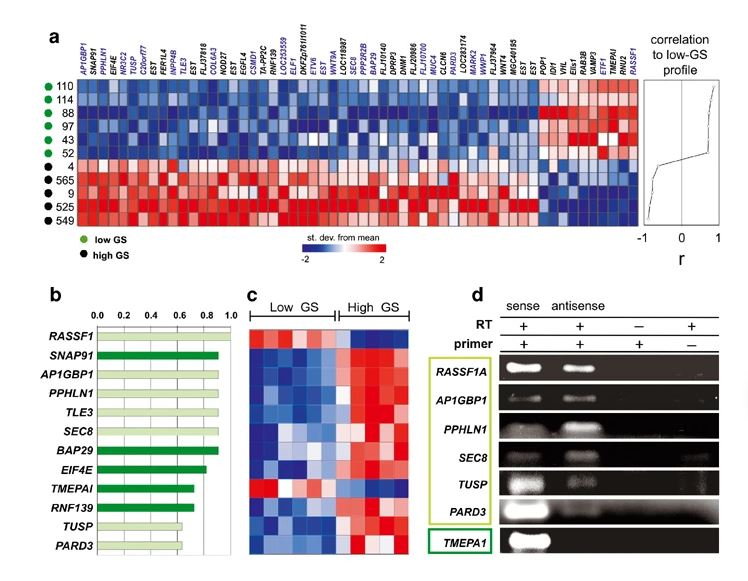Antisense intronic non-coding RNA levels correlate to the degree of tumor differentiation in prostate cancer.
A large fraction of transcripts are expressed antisense to introns of known genes in the human genome. Here we show the construction and use of a cDNA microarray platform enriched in intronic transcripts to assess their biological relevance in pathological conditions. To validate the approach, prostate cancer was used as a model, and 27 patient tumor samples with Gleason scores ranging from 5 to 10 were analyzed. We find that a considerably higher fraction (6.6%, [23/346]) of intronic transcripts are significantly correlated (P< or =0.001) to the degree of prostate tumor differentiation (Gleason score) when compared to transcripts from unannotated genomic regions (1%, [6/539]) or from exons of known genes (2%, [27/1369]). Among the top twelve transcripts most correlated to tumor differentiation, six are antisense intronic messages as shown by orientation-specific RT-PCR or Northern blot analysis with strand-specific riboprobe. Orientation-specific real-time RT-PCR with six tumor samples, confirmed the correlation (P=0.024) between the low/high degrees of tumor differentiation and antisense intronic RASSF1 transcript levels. The need to use intron arrays to reveal the transcriptome profile of antisense intronic RNA in cancer has clearly emerged.
Authors
Eduardo M Reis; Helder I Nakaya; Rodrigo Louro; Flavio C Canavez; Aurea V F Flatschart; Giulliana T Almeida; Camila M Egidio; Apuã C Paquola; Abimael A Machado; Fernanda Festa; Denise Yamamoto; Renato Alvarenga; Camille C da Silva; Glauber C Brito; Sérgio D Simon; Carlos A Moreira-Filho; Katia R Leite; Luiz H Camara-Lopes; Franz S Campos; Etel Gimba; Giselle M Vignal; Hamza El-Dorry; Mari C Sogayar; Marcello A Barcinski; Aline M da Silva; Sergio Verjovski-Almeida
External link
Publication Year
Publication Journal
Associeted Project
Long Noncoding RNAs
Lista de serviços
-
StructRNAfinder: an automated pipeline and web server for RNA families prediction.StructRNAfinder: an automated pipeline and web server for RNA families prediction.
-
CEMiTool: a Bioconductor package for performing comprehensive modular co-expression analyses.CEMiTool: a Bioconductor package for performing comprehensive modular co-expression analyses.
-
webCEMiTool: Co-expression Modular Analysis Made Easy.webCEMiTool: Co-expression Modular Analysis Made Easy.
-
Assessing the Impact of Sample Heterogeneity on Transcriptome Analysis of Human Diseases Using MDP Webtool.Assessing the Impact of Sample Heterogeneity on Transcriptome Analysis of Human Diseases Using MDP Webtool.
-
Predicting RNA Families in Nucleotide Sequences Using StructRNAfinder.Predicting RNA Families in Nucleotide Sequences Using StructRNAfinder.
-
OUTBREAK: a user-friendly georeferencing online tool for disease surveillance.OUTBREAK: a user-friendly georeferencing online tool for disease surveillance.
-
Noninvasive prenatal paternity determination using microhaplotypes: a pilot study.Noninvasive prenatal paternity determination using microhaplotypes: a pilot study.
-
Editorial: User-Friendly Tools Applied to Genetics or Systems Biology.Editorial: User-Friendly Tools Applied to Genetics or Systems Biology.
-
Automatic detection of the parasite Trypanosoma cruzi in blood smears using a machine learning approach applied to mobile phone imagesAutomatic detection of the parasite Trypanosoma cruzi in blood smears using a machine learning approach applied to mobile phone images
-
Tucuxi-BLAST: Enabling fast and accurate record linkage of large-scale health-related administrative databases through a DNA-encoded approachTucuxi-BLAST: Enabling fast and accurate record linkage of large-scale health-related administrative databases through a DNA-encoded approach
-
Ten quick tips for harnessing the power of ChatGPT in computational biologyTen quick tips for harnessing the power of ChatGPT in computational biology

